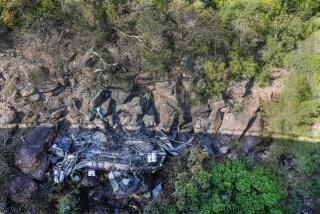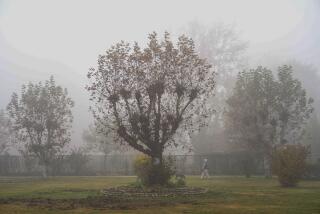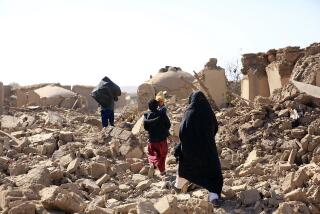30 killed when Afghan bus hits roadside bomb
KABUL, AFGHANISTAN — A crowded Afghan passenger bus struck a roadside bomb Tuesday in the violent southern province of Kandahar, killing 30 people and injuring more than three dozen others, Afghan officials said. As many as 10 children were reported to be among the dead.
The incident underscored the growing danger of road travel in much of Afghanistan, even on main highways, and the deadly peril faced by civilians in such mundane activities as walking to school, going to the market or riding a bus.
The United Nations reported last week that August had been the deadliest month so far this year for civilians, who often find themselves caught in fighting between Western troops and insurgents. At least 1,500 noncombatants had been killed this year through last month, the report said.
Roadside bombs are almost always meant for foreign troops. The crude but powerful devices cause far more Western troop casualties than clashes with the Taliban and other militants. But they are indiscriminate killers: Civilians also use the roads traveled by military convoys.
At the time of Tuesday’s blast, a contingent of soldiers had blocked off the main route to sweep it for explosives. The bus turned onto a parallel dirt road and struck a buried bomb.
Intercity buses are the main mode of transport for Afghan workers and families, few of whom can afford plane tickets across the country’s vast distances. The bus was traversing a popular route from the western city of Herat to Kandahar, the hub of southern Afghanistan. As on nearly all overburdened public transport in Afghanistan, passengers consisted of a mix of men, women and children.
The explosion, which left the bus charred and twisted, took place in the district of Maiwand, on Kandahar city’s western fringes. The area has long been a battlefield between Western troops and Taliban fighters. American troops have begun to take a greater combat role in Kandahar province, where until recently Canadians made up the bulk of foreign forces spread out in insurgent-ridden districts.
The Afghan Interior Ministry put the number of deaths from the blast at 30 and the injured at 39, though some local and provincial officials provided different figures. The toll changed several times in the course of the day.
Civilian deaths, caused either by foreign forces or the Taliban, have caused many Afghans to question the price of the nearly 8-year-old fight against the insurgents. The Obama administration is still struggling to come up with a coherent war strategy, even as some North Atlantic Treaty Organization allies question whether the conflict is winnable.
Battle fatigue on the part of the Afghan public has been compounded by the inconclusive results of the country’s presidential election in August, which had been touted as a chance for democracy to take stronger root here. Allegations of massive fraud prompted election officials to undertake a partial recount based on a statistical sampling of contested votes.
The initial tally gave President Hamid Karzai an almost 2-1 lead over his main rival, former Foreign Minister Abdullah Abdullah, but the recount is expected to shrink that lead. Karzai would need more than 50% of the vote to avoid a runoff against Abdullah, which would need to be held before harsh winter weather sets in.
--
Special correspondent M. Karim Faiez contributed to this report.
More to Read
Sign up for Essential California
The most important California stories and recommendations in your inbox every morning.
You may occasionally receive promotional content from the Los Angeles Times.










